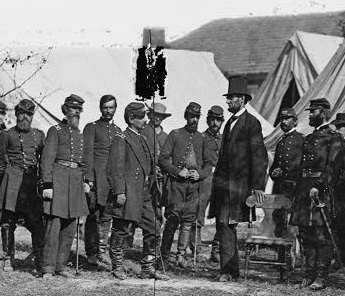33e. Bloody Antietam

This photo was taken on the Antietam battlefield in October 1862. A month later, on November 7, 1862 , Lincoln sacked General McClellan and replaced him with General Burnside.
McClellan is 4th to the left of President Lincoln.
Click the picture to enlarge. On the far right leaning against a tent is another famous general: George Armstrong Custer
The South was on the move.
In August 1862, a Confederate Army invaded Kentucky from Tennessee. They seized Frankfort and seated a Confederate governor. During that same month, Robert E. Lee's Army of Northern Virginia had defeated the Union Army again at the Second Battle of Bull Run.
Lee and Jefferson Davis believed that one more successful campaign might bring British and French recognition of the Confederacy. Foreign powers are reluctant to enter a conflict on the losing side. Although Britain and France both saw advantages of a split United States, neither country was willing to support the Confederacy without being convinced the South could win. Lee and Davis were desperately seeking that decisive victory.
Lee wanted to attack the North on its own territory. His target was the federal rail center at Harrisburg, Pennsylvania, but the Union General George McClellan was pursuing him. Lee decided to stop and confront the Union Army at Sharpsburg, Maryland. In front of the town ran a little creek called Antietam.
On September 15, Lee deployed his 30,000 soldiers on some four miles of rising ground behind Antietam Creek. He utilized the cover of rock outcroppings, rolling farmland, stone walls, fields of standing corn, and a sunken road in the center of his line.
Two days earlier, a Union corporal had found a copy of Lee's special orders wrapped around three cigars. But McClellan refused to act because he thought Lee's troops outnumbered his own. When McClellan started deploying his troops on September 16, he had 60,000 active soldiers and 15,000 in reserve. Had he thrust his complete force against the Confederates on September 15 or 16, he might have smashed Lee's army.

This map shows troop movements during the Battle of Antietam. Confederate troops are shown in red, Union troops in blue. (Click to enlarge)
The battle began early on the morning of September 17 when Union troops under the command of General Joseph Hooker attacked the forces of Stonewall Jackson across a cornfield that lay between them. The fighting was ferocious. The battle surged back and forth across the cornfield 15 times, costing each side nine generals. Within five hours, 12,000 soldiers lay dead or wounded, and the weary opponents stopped fighting for the day.
By midday, the struggle had shifted to a sunken country road between two farms. Two Confederate brigades stood their ground repeatedly as Union soldiers attacked and fell back. Finally, Union attackers assumed a position from which they could shoot down on the Confederate soldiers occupying the road. It was quickly filled with the dead and dying, sometimes two and three deep. The road earned a new name: Bloody Lane. The Confederates fell back, and McClellan again had the opportunity to cut Lee's army in two and ruin it. But McClellan did not follow through, and the battlefield fell silent.
This day sits in history as the bloodiest single day America has ever suffered. Over 22,000 soldiers were killed, wounded, or missing — more than all such casualties during the entire American Revolution. Lee lost a quarter of his army; the survivors headed back to Virginia the next night.
The horror of Antietam proved to be one of the war's critical events. Lee and Davis did not get their victory. Neither Britain nor France was prepared to recognize the Confederacy. Five days after the battle, Lincoln issued his preliminary Emancipation Proclamation. On November 5, Lincoln, impatient with McClellan's hesitancy, relieved him of command, and replaced him with General Ambrose Burnside.
Antietam changed everything.




